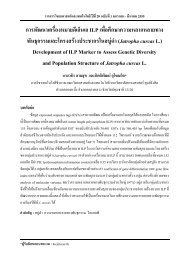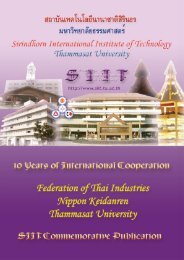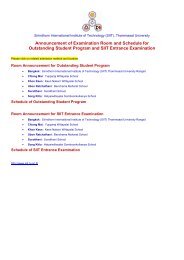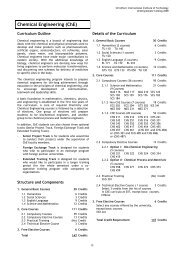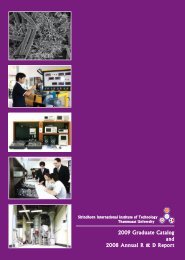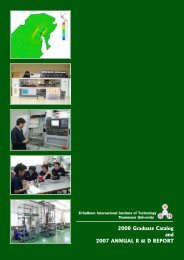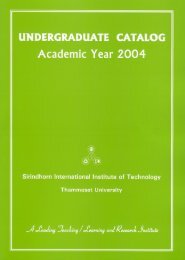2006 Graduate Catalog and 2005 Annual R & D Report - Sirindhorn ...
2006 Graduate Catalog and 2005 Annual R & D Report - Sirindhorn ...
2006 Graduate Catalog and 2005 Annual R & D Report - Sirindhorn ...
Create successful ePaper yourself
Turn your PDF publications into a flip-book with our unique Google optimized e-Paper software.
<strong>2006</strong> <strong>Graduate</strong> <strong>Catalog</strong> <strong>and</strong> <strong>2005</strong> <strong>Annual</strong> R & D <strong>Report</strong><br />
<strong>Sirindhorn</strong> International Institute of Technology (SIIT)<br />
School of Manufacturing Systems <strong>and</strong> Mechanical Engineering<br />
Faculty Members <strong>and</strong> Research Interests, <strong>2006</strong><br />
Dr. Bundit Limmeechokchai<br />
Associate Professor<br />
B.Eng. (1 st Class Honors) in Mechanical Engineering, King Mongkut's Institute of Technology North Bangkok<br />
M.Eng. in Rational Use of Energy, Asian Institute of Technology (AIT), Thail<strong>and</strong><br />
D.Eng. in Energy Economics <strong>and</strong> Planning, Asian Institute of Technology (AIT), Thail<strong>and</strong><br />
Areas of Specialization: Energy conservation <strong>and</strong> energy management in buildings, Dem<strong>and</strong>-side<br />
management, Integrated resource planning, Modeling of energy <strong>and</strong> environment systems.<br />
Research Interests:<br />
Energy Management <strong>and</strong> Energy Conservation<br />
Energy management is the effective use of energy to<br />
maximize profits (minimize costs). A comprehensive<br />
energy management program is not purely technical.<br />
It takes into account planning <strong>and</strong> communication as<br />
well as marketing. Energy management includes<br />
energy productivity <strong>and</strong> energy awareness. In<br />
Thail<strong>and</strong>, energy management in buildings <strong>and</strong><br />
industries is necessary to the country, as an energy<br />
importing country. The state has implemented energyconservation<br />
policies <strong>and</strong> measures for close to 20<br />
years with little evidence of success. On the other<br />
h<strong>and</strong>, the energy consumption <strong>and</strong> GDP per capita in<br />
constant 1980 US$ from 1973 to 1990 are highly<br />
correlated with an elasticity of 1.12, which shows<br />
energy-consumption growth. The Energy-Conservation<br />
Promotion (ECP). Act was passed in 1992 <strong>and</strong> has<br />
been implemented since 1996 with one objective being<br />
the promotion of energy efficiency in buildings <strong>and</strong><br />
industries.<br />
Integrated Resource Planning<br />
Traditionally, the method used in the power<br />
expansion process is to identify the sequence of<br />
generation additions which results in supplying the<br />
forecast load at the minimum overall costs, which has<br />
concentrated almost exclusively on supply-side<br />
options. However, it can be assumed that the saving<br />
of electricity through a dem<strong>and</strong> side management<br />
(DSM) program is equivalent to building a new power<br />
generating unit. This concept is known as integrated<br />
resource planning (IRP). Therefore, each of the<br />
programs in DSM program of the Thai power sector<br />
will be evaluated in the IRP process.<br />
Dr. Chakguy Prakasvudhisarn<br />
Assistant Professor<br />
B.Eng. in Computer Engineering, Chulalongkorn University, Bangkok, Thail<strong>and</strong><br />
M.S. in Computer Science, University of Oklahoma, OK, USA<br />
Ph.D. in Industrial Engineering, University of Oklahoma, OK, USA<br />
Areas of Specialization: Form Tolerance Evaluation, Automated Inspection (Vision <strong>and</strong> CMM systems),<br />
Computer Aided Manufacturing, Mathematical Programming, <strong>and</strong> Computational Intelligence (Support Vector<br />
Machines, Neural Networks, <strong>and</strong> Fuzzy Logic).<br />
Research Interests:<br />
Form Tolerance Evaluation<br />
Perfectly manufactured parts are nearly impossible to<br />
achieve due to variations in machining such as<br />
operators’ skills, tool characteristics, machine<br />
characteristics, <strong>and</strong> cost. Therefore, size <strong>and</strong><br />
geometric tolerances of finished parts must be<br />
inspected. Form tolerances, a type of geometric<br />
tolerances, are applicable to single (individual)<br />
features or elements of single features. A form<br />
tolerance specifies a minimum zone within which the<br />
considered feature must be contained. Some<br />
common types are straightness, flatness, circularity or<br />
roundness, <strong>and</strong> cylindricity. However, complex forms,<br />
such as conicity <strong>and</strong> torusity have been largely<br />
ignored in the coordinate form literature. The<br />
deviation models of such forms are of interest. Their<br />
minimum zone solutions are then determined.<br />
Computational Intelligence Approaches for<br />
Automated Inspection<br />
For complex forms, the deviation models are highly<br />
nonlinear <strong>and</strong> they may not be differentiable. This<br />
may result in impracticality of gradient-based<br />
nonlinear optimization approaches. Computational<br />
Intelligence approaches are taken into consideration<br />
as alternatives to find minimum zone verification. The<br />
form tolerances algorithms are developed by utilizing<br />
the advantages of these approaches. In addition,<br />
they can be incorporated with CMM controller<br />
software for automated parts inspection.<br />
32




